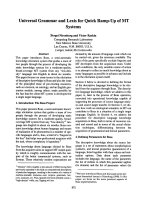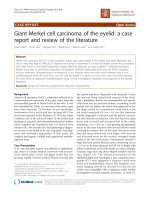báo cáo khoa học: "Esthesioneuroblastoma chemotherapy and radiotherapy for extensive disease: a case report" ppt
Bạn đang xem bản rút gọn của tài liệu. Xem và tải ngay bản đầy đủ của tài liệu tại đây (482.44 KB, 12 trang )
This Provisional PDF corresponds to the article as it appeared upon acceptance. Fully formatted
PDF and full text (HTML) versions will be made available soon.
Esthesioneuroblastoma chemotherapy and radiotherapy for extensive disease: a
case report
World Journal of Surgical Oncology 2011, 9:118 doi:10.1186/1477-7819-9-118
Seema Gupta ()
Nuzhat Husain ()
Sham Sundar ()
ISSN 1477-7819
Article type Case report
Submission date 10 June 2011
Acceptance date 5 October 2011
Publication date 5 October 2011
Article URL />This peer-reviewed article was published immediately upon acceptance. It can be downloaded,
printed and distributed freely for any purposes (see copyright notice below).
Articles in WJSO are listed in PubMed and archived at PubMed Central.
For information about publishing your research in WJSO or any BioMed Central journal, go to
/>For information about other BioMed Central publications go to
/>World Journal of Surgical
Oncology
© 2011 Gupta et al. ; licensee BioMed Central Ltd.
This is an open access article distributed under the terms of the Creative Commons Attribution License ( />which permits unrestricted use, distribution, and reproduction in any medium, provided the original work is properly cited.
Esthesioneuroblastoma chemotherapy and radiotherapy for extensive
disease: a case report
Seema Gupta
1,*
, Nuzhat Husain
2
, Sham Sundar
1
1
Department of Radiotherapy, C.S.M. Medical University, Lucknow, Uttar Pradesh, India
2
Department of Pathology, C.S.M. Medical University, Lucknow, Uttar Pradesh, India
Corresponding Author*
Dr. Seema Gupta
Associate Professor
Department of Radiotherapy
C.S. M. Medical University,
Erstwhile (King George’s Medical University)
Street- Chowk, Lucknow -226003 (U.P) India
Institution Phone No. +91-0522-2253316
Institution Fax. No. +91-0522-2258878
Email.
Emails NS SS
Abstract
Malignant tumors of the nasal cavity are rare. We report the case of a 48 years old man who
consulted us with a 2-year history of progressive nasal obstruction, occasional epistaxis,
facial pain, and watering of the eyes. A diagnosis of olfactory neuroblastoma was established
by histopathology and confirmed by immunohistochemistry. On staging, the mass was
classified as a Kadish stage C tumor with extensive involvement of the nasal cavities,
nasopharynx, paranasal sinuses and orbit. Endoscopic excision of the mass was done.
Traditionally the mainstay of treatment in such locally advanced patients is craniofacial
resection followed by adjuvant radiotherapy. Our patient was treated with limited surgery
and chemoradiation. Patient is free of recurrence at a follow-up of 5 years. This case report
demonstrates the potential efficacy of planned combined modality therapy, including limited
surgery and early chemoradiation in the control of locally advanced olfactory neuroblastoma.
Keywords: esthesioneuroblastoma, nasal cavity, pathology, immunohistochemistry,
treatment.
Background
Malignant tumors of the nasal cavity are rare. Olfactory neuroblastomas also known as
esthesioneuroblastomas (ENB) is a rare and aggressive malignant tumor accounting for only
6% of nasal cavity and paranasal sinus neoplasms and 0.3% of the upper aero digestive tract
malignancies [1].
Treatment recommendations range from a minimally invasive approach to
combined modality treatment including craniofacial resection and chemo radiotherapy [2].
Case Presentation
In June 2004, a 48 year old male presented with progressive bilateral nasal obstruction, and
bleeding through nostrils since 3 years associated with facial pain and blurred left eye vision
from 6 months.
Computed tomography dated- June 2004 (fig 1) showed large mass involving both nasal
cavities, paranasal sinuses, nasopharynx, left pterygoid plates, left pterygopalatine fossa,
hard palate, and orbit. There was no clinically or radiologically evident disease in neck, chest
or abdomen. An endoscopically guided biopsy disclosed esthesioneuroblastoma.
Histopathology section showed an infiltrating round cell tumor with areas of necrosis and
hemorrhage, partly ulcerating the overlying nasopharyngeal mature epithelium.Tumour cells
showed nuclear molding with occasional rosettes (fig 2, a and b).
Immunohistochemistry profile (fig 2, c and d) showed positivity for neural marker namely
neuron specific enolase. The tumor cells were negative for epithelial markers cytokeratin and
epithelial membrane antigen (fig 2, e and f) Hence a diagnosis of adult
esthesioneuroblastoma of nasal cavity was made.
Patient was planned for upfront chemotherapy followed by radiotherapy in June 2004.
Surgical excision in form of craniofacial surgical resection was not done due to non-
availability of technical advances and surgical expertise. Patient received 6 cycles of cisplatin
(20 mg/m
2
day1-5), etoposide (100mg/m
2
day1-5) and bleomycin (30mg day2, 9 and 16) at 3
weekly interval, followed by external beam radiotherapy. Radiotherapy was planned with
one anterior and two lateral wedge pair fields with unequal weighting and treatment was
delivered via Telecobalt Unit Theratron 780C ( AECL, Ottawa, Canada) with dose
normalized at tumor center. Dose homogeneity requirement was 95-105% of the specified
centrally absorbed dose, as mentioned in the ICRU 50-reference point. Two-dimensional
computer planning was done on Radplan software (TSG Corporation, India). Patient received
total dose of 56Gy in 28 fractions in 5 1/2 weeks.
Post radiation patient had significant improvement in symptoms but CT-Scan revealed
residual disease (fig 3), therefore 4 more cycles of cisplatin (20 mg/m
2
day1-5) and etoposide
(100mg/m
2
day1-5) chemotherapy was given at 3 weekly interval. Treatment was completed
in June 2005; subsequently our patient has been clinically asymptomatic through out the
follow up period of 5 yrs. The latest C.T scan done in June 2010 (fig 4)showed evidence of
post radiation changes most likely to be fibrosis in left maxillary antrum with marked new
bone formation and no sign of disease.
Discussion
Extension of primary tumor based on the Kadish staging system has been identified as the
most important determinant of the treatment outcome [3, 4].
Our patient who presented with locally advanced disease Kadish stage C without intracranial
extension was treated with limited surgery combined with chemoradiotherapy which has
shown good response and disease free survival of 5 years. Presently our patient is clinically
and radiologically free of disease.
Craniofacial surgery is the mainstay of treatment in ENB regardless of stage and grade with
the possible exception of distance metastasis followed by adjuvant radiation in high grade
and locally advanced tumors. [5]. In unresectable ENB the experience with chemoradiation is
lacking and is under-reported probably due to limited cases, but some of the latest series have
shown promising results in nonsurgical approach [2].
Encouraged by these results we treated our patient who had locally advanced disease by
limited surgery due to non-availability of technical advances and surgical expertise
followed by chemo radiation, with excellent clinical outcome.
Conclusion
Chemoradiation along with limited surgery can be considered as one of the treatment
modalility for locally advanced ENB with promising results.
Consent
Written informed consent was obtained from the patient for publication of this case report
and accompanying images. A copy of the written consent is available for review by the
Editor-in-Chief of this journal.
Competing Interests:
The authors declare that they have no competing interests.
Authors' contributions
SG carried out the history, examination, treatment and the provisional draft. NH carried out
the histopathology and Immunohistochemistry. SS involved in the patient management and
data collection. All authors read and approved the final manuscript.
References:
1. Svane-Knudsen V, Jorgensen KE, Hansen O, Lindgren A, Marker P: Cancer of the
nasal cavityand paranasal sinuses: a series of 115 patients. Rhinology 1998, 36:12-4.
2. Bhattacharyya N, Thornton AF, Joseph MP, Goodman ML, Amrein PC. Successful
treatment of esthesioneuroblastoma and neuroendocrine carcinoma with combined
chemotherapy and proton radiation. Results in 9 cases. Arch otolaryngol head neck surg
1997, 123:34-40.
3 Foote RL, Morita A, Ebersold MJ, Olsen KD, Lewis JE, Quast LM, Ferguson JA,
O’Fallon WM. Esthesioneuroblastoma. The role of adjuvant radiation therapy. Int J
Radiat Oncol Biol Phys1993, 27:835-42.
4. Broich G, Pagliari A, Ottaviani F. Esthesioneuroblastoma. A general review of the cases
published since the discovery of the tumor in 1924. Anticancer Res 1997, 17:2683-706.
5. Biller HF, Lawson W, Sachdev VP, Som P. Esthesioneuroblastoma: Surgical treatment
without radiation. Laryngoscope 1990, 100:1199-1201.
Figures:
Figure: 1 Pre-treatment axial and coronal paranasal sinuses and orbit contrast-enhanced CT-
Scan (a, b). Showing bulky soft-tissue mass in left maxilla, bilateral ethmoid sinuses, nasal
cavity, pterygopalatine fossa, nasopharynx with destruction of medial and lateral wall of
orbit.
Figure: 2 Microphotograph showing small cells with rosettes (H & E x 125 x
digital magnification) (a, b) neuron specific enolase positive in tumor cells(c, d), Cytokeratin
and epithelial membrane antigen negative in tumor (DAB x 125 x digital magnification) (e,
f).
Figure: 3 Axial and coronal contrast-enhanced paranasal sinuses and orbit CT-scan after 6
cycles of chemotherapy and radiotherapy (a, b). showing marked reduction in the tumor, the
lesion is limited to the left maxillary sinus. A partial tumor remission was considered.
Figure: 4 Axial and coronal contrast-enhanced paranasal sinuses and orbit computed
tomography scan after completion of treatment (a, b). The scan is showing post radiation
changes most likely to be fibrosis.
Figure 1
Figure 2
Figure 3
Figure 4









